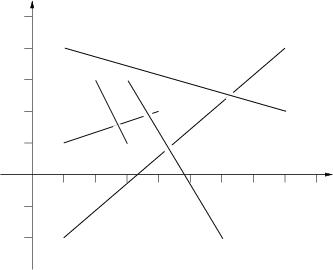POJ 2653 Pick-up sticks (线段相交)
题目:
Description
Stan has n sticks of various length. He throws them one at a time on the floor in a random way. After finishing throwing, Stan tries to find the top sticks, that is these sticks such that there is no stick on top of them. Stan has noticed that the last thrown stick is always on top but he wants to know all the sticks that are on top. Stan sticks are very, very thin such that their thickness can be neglected.
Input
Input consists of a number of cases. The data for each case start with 1 <= n <= 100000, the number of sticks for this case. The following n lines contain four numbers each, these numbers are the planar coordinates of the endpoints of one stick. The sticks are listed in the order in which Stan has thrown them. You may assume that there are no more than 1000 top sticks. The input is ended by the case with n=0. This case should not be processed.
Output
For each input case, print one line of output listing the top sticks in the format given in the sample. The top sticks should be listed in order in which they were thrown.
The picture to the right below illustrates the first case from input.
The picture to the right below illustrates the first case from input.

Sample Input
5
1 1 4 2
2 3 3 1
1 -2.0 8 4
1 4 8 2
3 3 6 -2.0
3
0 0 1 1
1 0 2 1
2 0 3 1
0
Sample Output
Top sticks: 2, 4, 5.
Top sticks: 1, 2, 3.
题意:给出n条线段 按照先后顺序 如果后来有线段和其相交 就当作覆盖掉这条线段 求没有被覆盖的线段
思路:数据只有1000 可以暴力相求
代码:
#include <iostream> #include <cstdio> #include <cstdlib> #include <cmath> #include <string> #include <cstring> #include <algorithm> using namespace std; typedef long long ll; typedef unsigned long long ull; const int inf=0x3f3f3f3f; const int maxn=1e5+10; const double eps=1e-10; int n; double x,y,xx,yy; int vis[maxn]; int dcmp(double x){ if(fabs(x)<eps) return 0; if(x<0) return -1; else return 1; } struct Point{ double x,y; Point(){} Point(double _x,double _y){ x=_x,y=_y; } Point operator + (const Point &b) const { return Point(x+b.x,y+b.y); } Point operator - (const Point &b) const { return Point(x-b.x,y-b.y); } double operator * (const Point &b) const{ return x*b.x+y*b.y; } double operator ^ (const Point &b) const{ return x*b.y-y*b.x; } }; struct Line{ Point s,e; Line(){} Line(Point _s,Point _e){ s=_s,e=_e; } }line[maxn]; bool inter(Line l1,Line l2){ return max(l1.s.x,l1.e.x)>=min(l2.s.x,l2.e.x) && max(l2.s.x,l2.e.x)>=min(l1.s.x,l1.e.x) && max(l1.s.y,l1.e.y)>=min(l2.s.y,l2.e.y) && max(l2.s.y,l2.e.y)>=min(l1.s.y,l1.e.y) && dcmp((l2.s-l1.s)^(l1.e-l1.s))*dcmp((l2.e-l1.s)^(l1.e-l1.s))<=0 && dcmp((l1.s-l2.s)^(l2.e-l2.s))*dcmp((l1.e-l2.s)^(l2.e-l2.s))<=0; } int main(){ while(~scanf("%d",&n)){ if(n==0) break; for(int i=1;i<=n;i++){ scanf("%lf%lf%lf%lf",&x,&y,&xx,&yy); line[i]=Line(Point(x,y),Point(xx,yy)); vis[i]=1; } for(int i=1;i<=n;i++){ for(int j=i+1;j<=n;j++){ if(inter(line[i],line[j])){ vis[i]=0; break; } } } printf("Top sticks: "); int flag=1; for(int i=1;i<=n;i++){ if(vis[i]){ if(flag) flag=0; else printf(", "); printf("%d",i); } } printf(".\n"); } return 0; }



